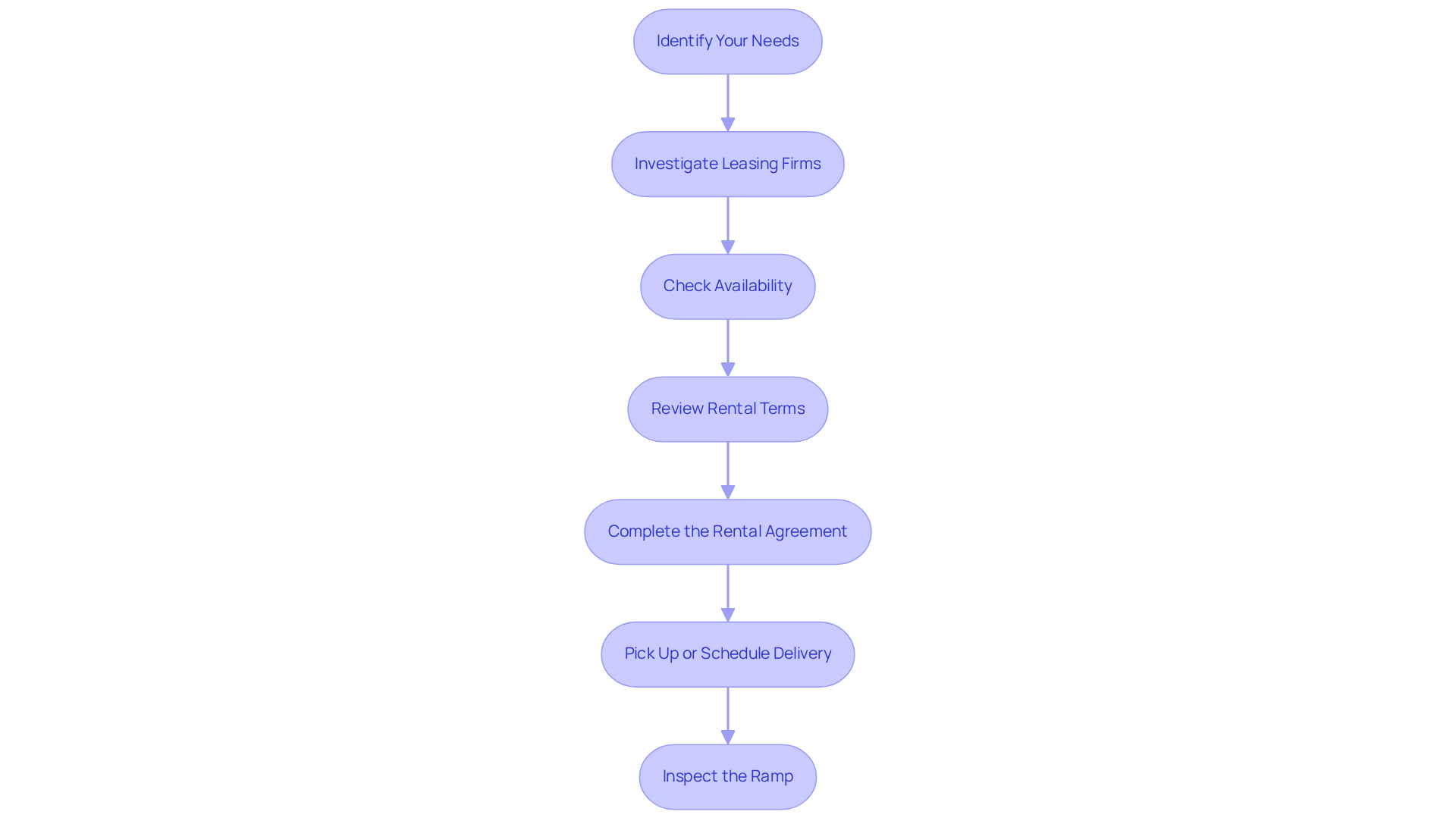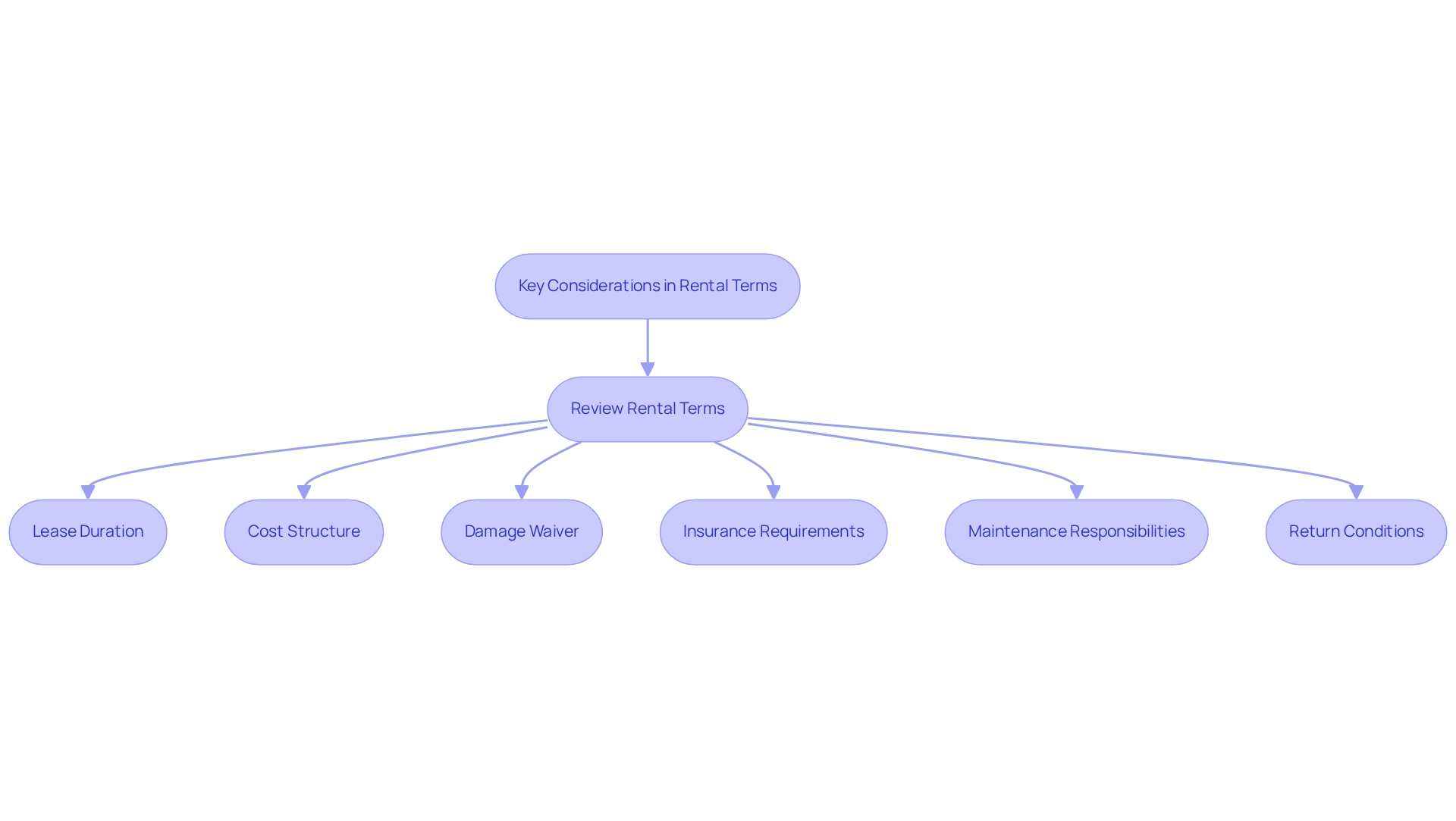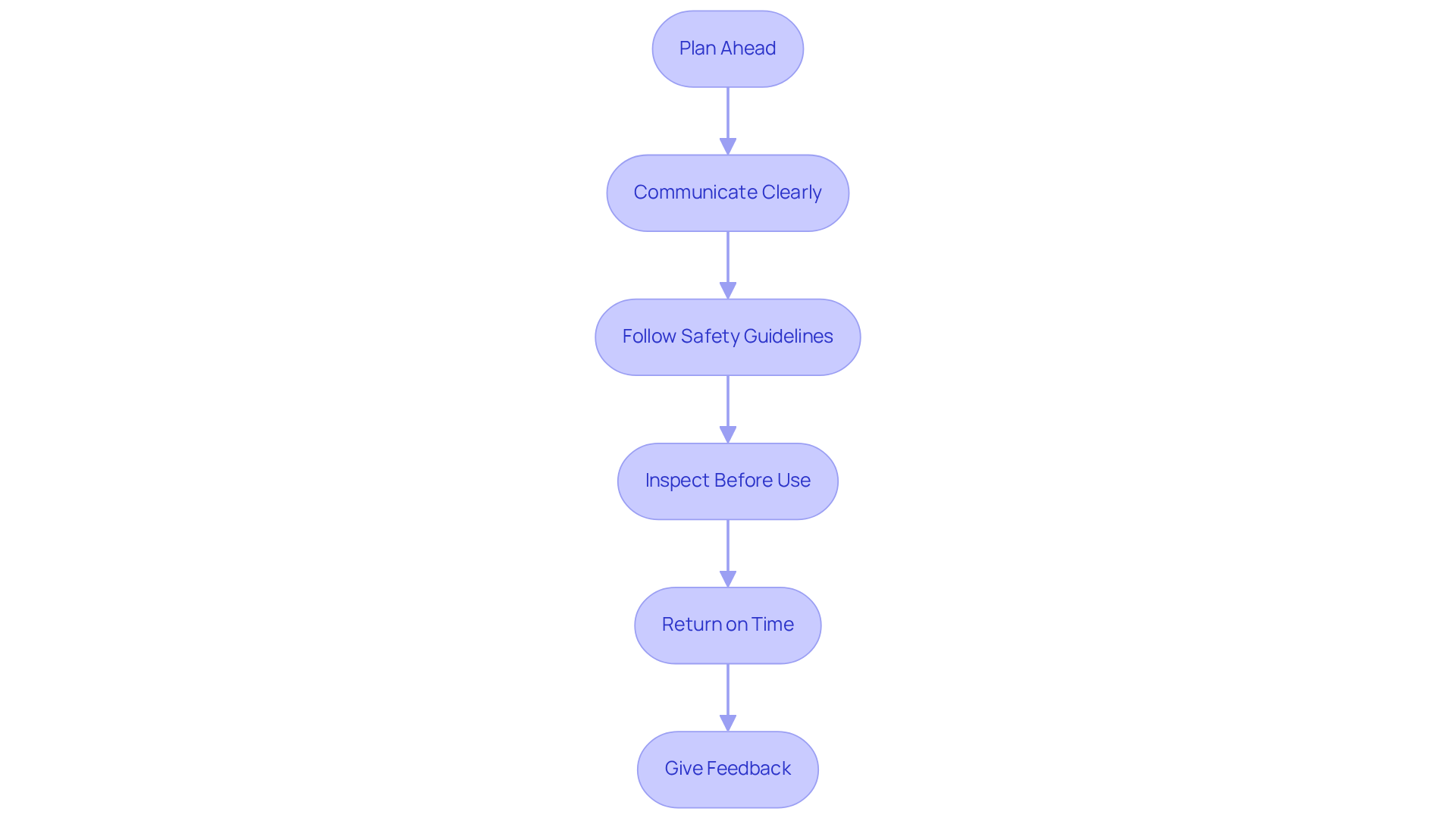Overview
This article presents a systematic approach to renting loading ramps for construction projects. It emphasizes the critical importance of:
- Identifying specific needs
- Checking availability
- Reviewing rental terms
By detailing the various types of ramps available, it outlines the essential steps in the rental process and best practices that ensure a successful rental experience. This comprehensive approach facilitates informed decision-making for project managers, empowering them to choose the right equipment with confidence.
Key Highlights:
- Loading ramps are essential tools for construction, available in various types for specific applications.
- Folding inclines are portable and ideal for light to medium loads, suitable for residential moving.
- Non-folding structures are robust and fixed for heavier loads, ensuring safety in industrial applications.
- Aluminium structures are lightweight and rust-resistant, making them versatile for loading vehicles.
- Steel inclines are durable and preferred for heavy machinery in industrial settings.
- Yard inclines are portable and designed for loading/unloading trucks, enhancing operational efficiency.
- A systematic rental process includes identifying needs, checking availability, reviewing rental terms, and inspecting the ramp.
- Key rental considerations include lease duration, cost structure, damage waivers, insurance requirements, maintenance responsibilities, and return conditions.
- Best practises for ramp rental include planning ahead, clear communication, following safety guidelines, inspecting ramps before use, returning on time, and providing feedback.
Introduction
Navigating the complexities of construction projects requires specialized equipment, and loading ramps are essential tools that significantly enhance both efficiency and safety on site. This guide explores the critical steps for renting loading ramps, emphasizing the various types available and best practices to ensure a seamless rental experience.
With numerous options and rental terms to consider, project managers must make informed decisions that align with their specific needs and budget. By addressing these questions, construction professionals can optimize their operations and avoid common pitfalls in the ramp rental process.
Understand Loading Ramps: Types and Uses
To facilitate construction, companies can rent loading ramps, which are essential tools available in various types tailored for specific applications. Here are some common types:
- Folding Inclines: These portable structures are easily stored when not in use, making them ideal for light to medium loads. Their versatility allows for use in residential moving and temporary sites, providing immediate solutions without permanent installations.
- Non-Folding Structures: Typically more robust, non-folding structures are designed for heavier loads. Often fixed in place, they offer a stable loading surface, crucial for industrial applications where safety and reliability are paramount.
- Aluminum Structures: Recognized for their lightweight and rust-resistant characteristics, aluminum structures are appropriate for diverse uses, such as loading vehicles and equipment. Their ease of transport and setup makes them a popular choice in dynamic work environments.
- Steel Inclines: Heavier and more durable, steel inclines are ideal for industrial settings where heavy machinery is involved. Their strength guarantees they can manage substantial weight, making them a favored choice for building endeavors needing sturdy solutions.
- Yard Inclines: Specifically designed for loading and unloading trucks, yard inclines are portable and can be relocated as needed. Their flexibility enhances operational efficiency, allowing for quick adjustments in busy logistics environments.
Comprehending these categories is essential for choosing the appropriate incline for your building endeavor, guaranteeing both safety and efficiency. As emphasized by EZ Equipment Rental, forklifts play a crucial role in improving efficiency and safety in building projects, especially when you rent loading ramps. EZ Equipment Rental also offers flexible rental terms and competitive pricing, making it easier for project managers to access the right equipment. As Stephen Nohra, a construction expert, emphasizes, "A well-informed decision today can enhance your business productivity for years to come." This insight underscores the significance of selecting the suitable incline to address specific operational requirements. Moreover, educating staff on safe platform usage and ensuring the incline angle is between 15 and 20 degrees are crucial for maintaining safety during operations.

Follow the Rental Process: Step-by-Step Instructions
To rent loading ramps for your construction project, adhere to the following steps:
- Identify Your Needs: Begin by evaluating the weight and dimensions of the items you will be loading or unloading. This assessment will guide you in determining the suitable type of incline.
- Investigate leasing firms to find trustworthy options to rent loading ramps in your vicinity. Consider options like EZ Equipment Leasing, which is recognized for its varied assortment of loading platforms.
- Check Availability: Reach out to your chosen leasing firm to confirm the availability of your preferred incline. Additionally, if necessary, inquire about the delivery options for rent loading ramps.
- Review Rental Terms: Familiarize yourself with the rental agreement. Pay attention to the duration, costs, and any additional fees that may apply.
- Complete the Rental Agreement by filling out the necessary paperwork to rent loading ramps, ensuring you provide required identification or business information.
- Pick Up or Schedule Delivery: Finally, decide whether to collect the equipment yourself or arrange for delivery to your job site.
- Inspect the Ramp: Before use, thoroughly inspect the ramp for any damage or defects. This step is crucial to ensure safe operation.

Review Rental Terms: Key Considerations and Conditions
When reviewing rental terms, it is essential to consider the following key points:
- Lease Duration: Familiarize yourself with the minimum and maximum lease periods. Companies frequently have specific policies for short-term versus long-term leases, which can significantly impact your project timeline.
- Cost Structure: Understand the base leasing fee alongside any additional costs, such as delivery, pickup, or late return charges. For example, a Texas-based leasing firm imposes a $50/hour late return charge, which has been shown to decrease late returns by 35%. This can substantially affect your overall costs.
- Damage Waiver: Inquire whether the leasing company offers a damage waiver. This option can protect you from liability for accidental damage to the ramp, providing peace of mind during your project.
- Insurance Requirements: Be prepared to provide evidence of insurance, as some companies mandate this before renting equipment. Ensure your coverage meets their requirements to avoid complications.
- Maintenance Responsibilities: Clarify maintenance responsibilities during the rental period. While EZ Equipment Rental typically manages maintenance, confirming this detail is crucial to prevent unexpected issues.
- Return Conditions: Understand the return conditions for the incline, including cleanliness and any necessary inspections. Adhering to these conditions can help you avoid additional fees and ensure a smooth return process.
By evaluating these elements, project managers can make informed decisions when they rent loading ramps, which ensures a successful project outcome.

Implement Best Practices: Tips for Successful Ramp Rental
To ensure a successful ramp rental experience, consider the following best practices:
- Plan Ahead: Always rent your ramps in advance to avoid last-minute issues, particularly during peak construction seasons. Planning ahead is essential for a seamless rental process.
- Communicate Clearly: Maintain open lines of communication with the leasing company regarding your specific requirements and any modifications to your timeline. Effective communication is crucial; as noted by industry experts, it can significantly enhance project management efficiency and reduce risks. For example, Peter Drucker emphasizes that effective communication requires listening as much as speaking, which is vital in leasing agreements.
- Follow Safety Guidelines: Adhere strictly to safety protocols when utilizing the inclined surfaces. This includes understanding proper loading techniques and respecting weight limits to ensure compliance and safety on-site when you rent loading ramps. Recent statistics indicate that safety compliance rates in construction equipment leases are critical, as non-compliance can lead to accidents and increased liability.
- Inspect Before Use: Conduct a thorough examination of the incline prior to utilization to identify any potential safety hazards. This proactive approach can prevent accidents and ensure smooth operations.
- Return on Time: Ensure that you return the ramp punctually to avoid late fees and maintain a positive relationship with the leasing company. Punctuality demonstrates professionalism and respect for the lease agreement.
- Give Feedback: After the leasing period, provide constructive comments to the leasing company regarding your experience. This not only helps them improve their services but also assists future customers in making informed decisions. Sharing examples of effective communication during your rental experience can provide valuable insights for both the rental company and other project managers.

Conclusion
Renting loading ramps is a strategic decision that significantly enhances the efficiency and safety of construction projects. By understanding the various types of ramps available and following a structured rental process, project managers can ensure they select the right equipment tailored to their specific needs. This careful approach not only streamlines operations but also mitigates risks associated with improper loading and unloading practices.
The rental process involves key steps:
- Identifying needs and selecting reputable leasing companies
- Reviewing rental terms
- Implementing best practices
Critical considerations such as lease duration, cost structure, and safety compliance are emphasized, ensuring that project managers are well-equipped to navigate the complexities of ramp rentals. Furthermore, maintaining open communication with rental firms and adhering to safety guidelines are crucial for a successful rental experience.
Ultimately, the effective use of loading ramps leads to improved productivity and safety on construction sites. By taking the time to educate staff on proper usage and conducting thorough inspections before use, project managers can foster a culture of safety and efficiency. Embracing these practices not only enhances project outcomes but also contributes to a reputation for professionalism and reliability in the construction industry.
Frequently Asked Questions
What are loading ramps and why are they important in construction?
Loading ramps are essential tools used in construction to facilitate the movement of materials and equipment. They are available in various types tailored for specific applications, making them important for enhancing efficiency and safety on job sites.
What are the different types of loading ramps?
The main types of loading ramps include:
- Folding Inclines: Portable and ideal for light to medium loads, easily stored when not in use.
- Non-Folding Structures: More robust, designed for heavier loads, and typically fixed in place for stability.
- Aluminum Structures: Lightweight and rust-resistant, suitable for diverse uses including loading vehicles and equipment.
- Steel Inclines: Heavier and durable, ideal for industrial settings involving heavy machinery.
- Yard Inclines: Portable ramps designed for loading and unloading trucks, offering flexibility in logistics environments.
How do I choose the appropriate loading ramp for my project?
To choose the right loading ramp, consider the weight of the loads you will be handling, the environment in which it will be used, and whether you need a portable or fixed solution. Understanding the specific requirements of your building endeavor is crucial for ensuring safety and efficiency.
What safety considerations should I keep in mind when using loading ramps?
It is important to educate staff on safe platform usage and ensure that the incline angle is maintained between 15 and 20 degrees to prevent accidents during operations.
How can renting loading ramps benefit my construction project?
Renting loading ramps can improve efficiency and safety in building projects. EZ Equipment Rental offers flexible rental terms and competitive pricing, making it easier for project managers to access the right equipment for their specific needs.
What role do forklifts play in conjunction with loading ramps?
Forklifts enhance efficiency and safety in building projects, especially when used with loading ramps, by facilitating the movement of heavy materials and equipment.




